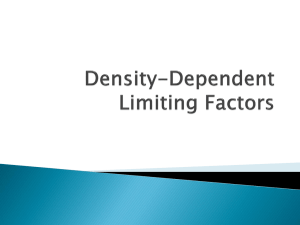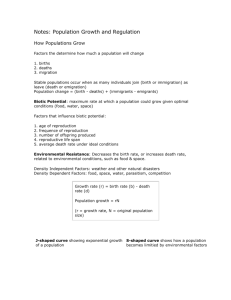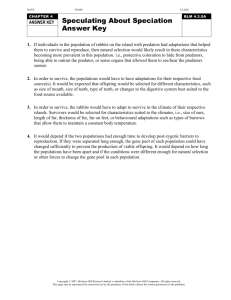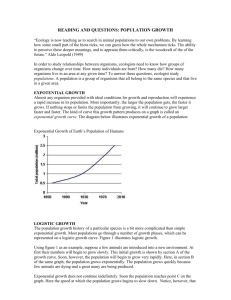Study Guide for the Final Examination
advertisement
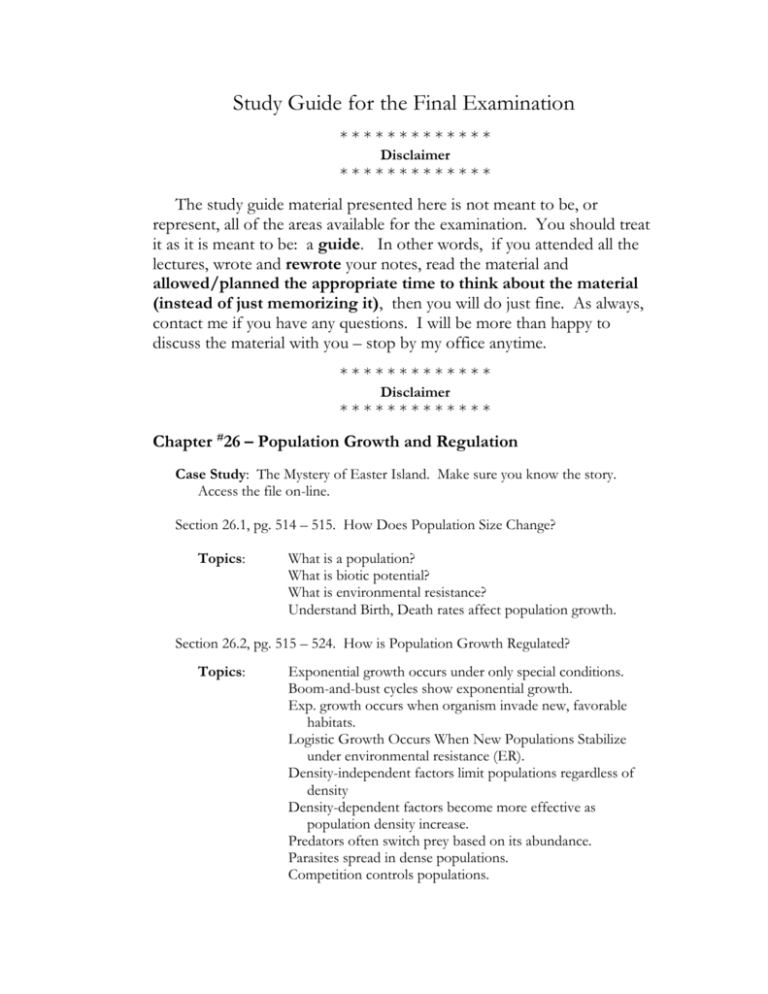
Study Guide for the Final Examination ************* Disclaimer ************* The study guide material presented here is not meant to be, or represent, all of the areas available for the examination. You should treat it as it is meant to be: a guide. In other words, if you attended all the lectures, wrote and rewrote your notes, read the material and allowed/planned the appropriate time to think about the material (instead of just memorizing it), then you will do just fine. As always, contact me if you have any questions. I will be more than happy to discuss the material with you – stop by my office anytime. ************* Disclaimer ************* Chapter #26 – Population Growth and Regulation Case Study: The Mystery of Easter Island. Make sure you know the story. Access the file on-line. Section 26.1, pg. 514 – 515. How Does Population Size Change? Topics: What is a population? What is biotic potential? What is environmental resistance? Understand Birth, Death rates affect population growth. Section 26.2, pg. 515 – 524. How is Population Growth Regulated? Topics: Exponential growth occurs under only special conditions. Boom-and-bust cycles show exponential growth. Exp. growth occurs when organism invade new, favorable habitats. Logistic Growth Occurs When New Populations Stabilize under environmental resistance (ER). Density-independent factors limit populations regardless of density Density-dependent factors become more effective as population density increase. Predators often switch prey based on its abundance. Parasites spread in dense populations. Competition controls populations. Section 26.3, pg. 524 – 526. How are Populations Distributed in Space & Time? Topics: Section 26.4, pg. Topics: Populations exhibit Different Spatial Distributions (3 types). Survivorship in Populations follows 3 patterns (know them). 526 – 532. How is the Human Population Changing? What is demography? The Human population continues to grow rapidly. Technological advances have increased the Earth’s capacity. Demographic transition helps stabilize populations. Population growth in unevenly distributed. A population’s age structure predicts its growth. Replacement level fertility. Chapter #27 – Community Interactions Section 27.1, pg. 538 – 538. Why are community interactions important? Topics: What is a community? What is coevolution? Section 27.2, pg. 538 – 540. What is the relationship between niche and competition? Topics: Define the ecological niche, both realized and fundamental. Competition occurs whenever two organism attempt to use the same, limited resources. Adaptations reduce the overlap of ecological niches among coexisting species. Know the competitive exclusion principle. Know resource partitioning. Interspecific competition may reduce the population size and distribution of each species. Competition with a species is a major factor controlling population size. Section 27.3, pg. 540 – 54546. What are the results of interactions between predators and prey? Topics: Predator-prey interactions shape evolutionary adaptations. Some predators have evolved counteracting behaviors. Camouflage conceals both predators and their prey. Mimicry and bright colors are unique mechanisms. Plants and herbivores have coevolutionary adaptations. Know symbiosis – commensalism, parasitism, mutualism. Section 27.5, pg. 549 – 550. How do Keystone species influence community structure? Topics: Know keystone species. Section 14.4, pg. 288 – 289. What is the Evidence? Topics: Evolution by natural selection today. Chapter #28 – How Do Ecosystems Work? Section 28.1, pg. 560 – 561. What are the pathways of energy and nutrients? Topics: What is an ecosystem and how does it differ from a community? Know the energy relationships, nutrient cycling, and feeding relationships in ecosystems. Section 28.2, pg. 298 – 303. How does energy flow through communities.? Topics: Energy enters communities via photosynthesis. Know the following names: Autotrophs Heterotrophs Primary producers (Net) Primary production Secondary consumers Tertiary consumers Quaternary consumers Decomposers and Detritivores Biomass Trophic Levels Food chains and food webs describe the feeding relationships within communities. Energy pyramids illustrate energy transfer between trophic levels. Food chains magnify toxic substances. Section 28.3, pg. 305 – 306. How do nutrients move within and among ecosystems? Topics: Micronutrients and macronutrients. Biogeochemical cycles (N2, C, and H2O) Carbon cycles throughout the atmospheres, oceans, and Communities.
